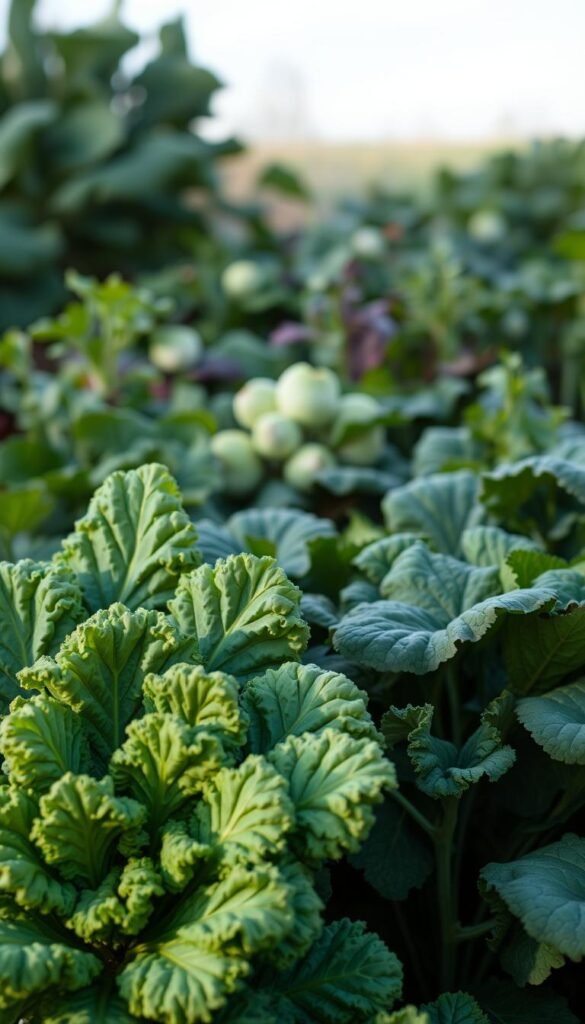Imagine stepping outside on a crisp morning to gather fresh, vibrant leaves from your backyard. Even as frost dusts the ground, certain plants not only survive but flourish in cooler conditions, offering a surprising bounty when traditional gardens sleep.
Many leafy greens develop sweeter, more complex flavors after facing chilly nights. This natural process, called cold sweetening, transforms ordinary crops into flavor-packed superfoods right in your own yard. You’ll find that maintaining a productive outdoor space during colder months requires different strategies than summer cultivation.
This guide reveals practical methods for protecting plants from extreme weather while maximizing yields. Learn how to select cold-tolerant varieties that laugh at freezing temperatures, and discover simple techniques to shield your garden beds effectively. From understanding soil insulation to timing your plantings perfectly, these insights apply whether you’re nurturing a balcony container garden or managing raised beds.
First-time growers and experienced green thumbs alike will appreciate how extending the growing season creates new opportunities. Picture serving salads made from leaves harvested hours before dinner, even as snow blankets the neighborhood. Let’s explore how to make your outdoor space work harder through every season.
Embracing the Winter Garden: Benefits and Challenges
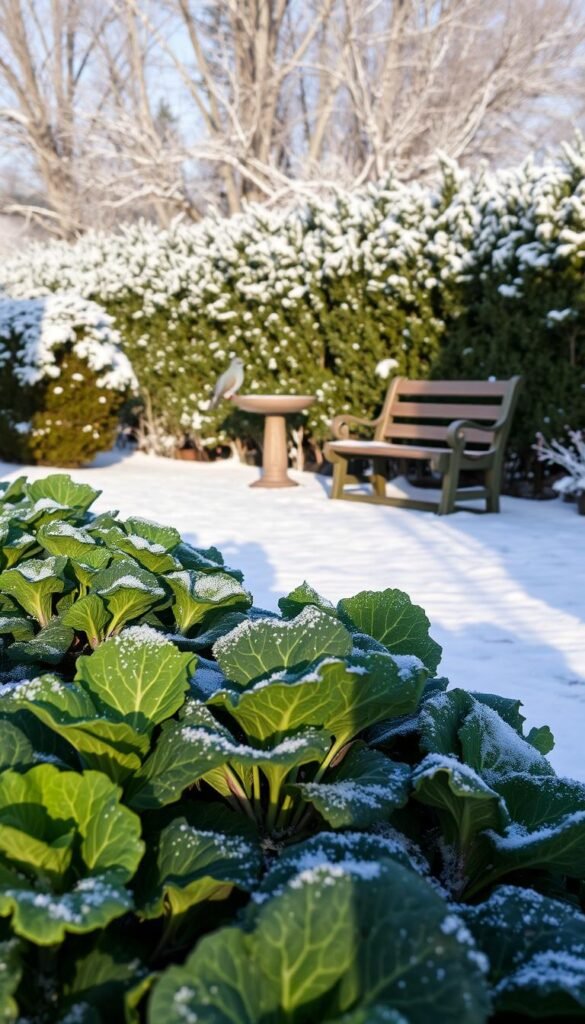
Growing food in colder months unlocks rewards you won’t find in summer. Crisp air transforms ordinary plants into sugar-rich treats—carrots taste like candy after frosty nights. Your plants face fewer pests too, as most bugs vanish when temperatures drop.
- Sweeter harvests: Cold triggers starch-to-sugar shifts, boosting flavor
- Low-maintenance care: Less watering, no scorching heat stress
- Nutrient-packed meals: Leaves store more vitamins when days shorten
But challenges exist. Shorter daylight slows growth, so timing matters. You’ll need to plant early enough for crops to mature before deep cold arrives. Sudden temperature swings also demand smart protection—like cold-hardy crops that laugh at 20°F weather.
Success hinges on two factors: knowing your local frost dates and choosing resilient varieties. Semi-hardy types handle light frosts (28-32°F), while tougher ones survive below freezing. With planning, your garden becomes a frost-defying marvel—quietly thriving while others sleep.
Choosing Cold-Hardy Vegetables: From Kale to Spinach
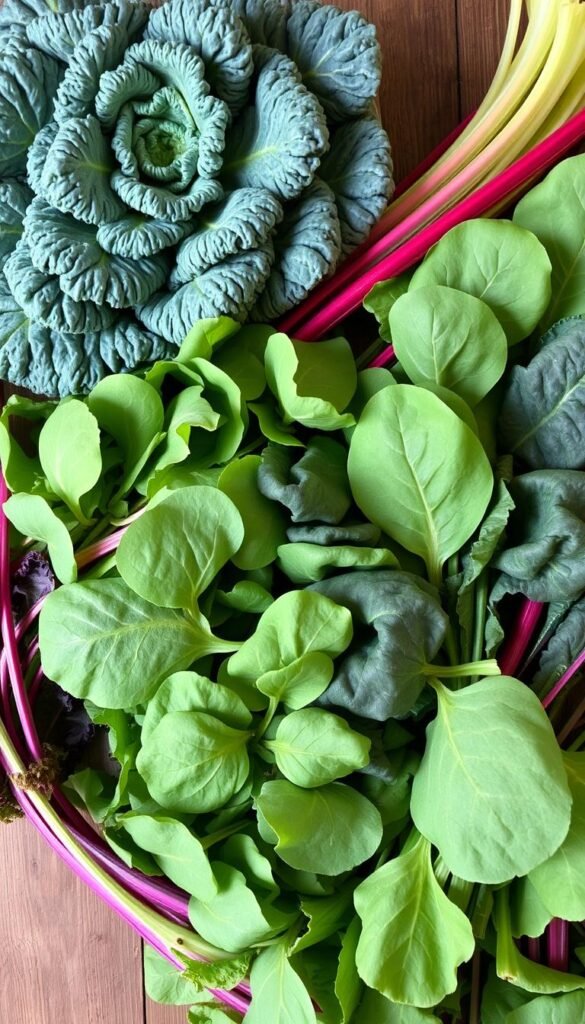
Selecting the right plants transforms chilly days into harvest opportunities. Frost-resistant picks thrive when others wilt, offering crisp textures and bold flavors. Let’s explore standout performers that turn frosty mornings into salad victories.
Kale Champions for Frosty Conditions
Three kale varieties dominate cold-weather gardens. Lacinato (dinosaur kale) develops richer flavor after light frosts, while Blue Curled Scotch maintains its crunch under protective covers. Compact Vates resists yellowing, perfect for small spaces.
| Variety | Cold Tolerance | Best Use |
|---|---|---|
| Lacinato | Down to 10°F | Flavor enhancement |
| Blue Curled Scotch | 5°F with cover | Continuous harvest |
| Vates | 15°F | Container gardening |
Spinach and Beyond: Frost-Friendly Favorites
Bloomsdale Longstanding spinach survives zone 6b winters unprotected. For extreme cold, Giant Winter handles 5°F temperatures thanks to its crinkled, insulating leaves. Pair these with Swiss chard or Asian greens for diversity.
Yellow Heart Winter Choy adds both beauty and bite to gardens, surviving 15°F temperatures. For those exploring protected growing spaces, tatsoi makes an excellent spinach alternative with its cold-resistant rosettes.
Preparing Your Garden for Cold Weather
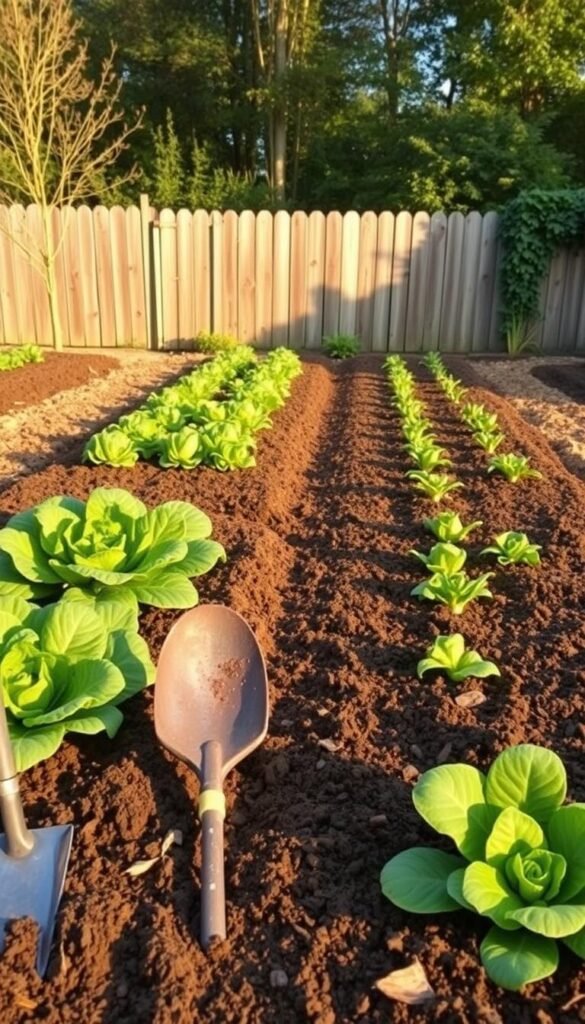
Your garden’s resilience starts below the surface. Proper groundwork ensures soil health and protects tender roots when temperatures plummet. Let’s break down the essential steps to create a thriving ecosystem for your cold-season greens.
Soil Preparation and Mulching Techniques
Begin by testing drainage—soggy earth suffocates roots faster than frost. Mix in compost or aged manure 4-6 weeks before planting. This gives microbes time to work magic, boosting nutrients and creating air pockets for water flow.
- Timing matters: Finish amendments before the ground chills completely
- Layer smartly: Straw or shredded leaves insulate best—avoid thick mats
- Moisture lock: Mulch retains water during dry spells, reducing winter watering
Apply mulch after the first light frost but before deep freezes. A 3-inch blanket stabilizes soil temps, preventing disruptive freeze-thaw cycles. For extended growing seasons, combine these methods with protective structures like cold frames.
Remember: Over-mulching traps too much heat. Let plants acclimate naturally to cooler weather before tucking them in. With well-prepared earth and strategic coverage, your garden becomes a fortress against harsh conditions.
Seed Selection and Starting for a Winter Harvest
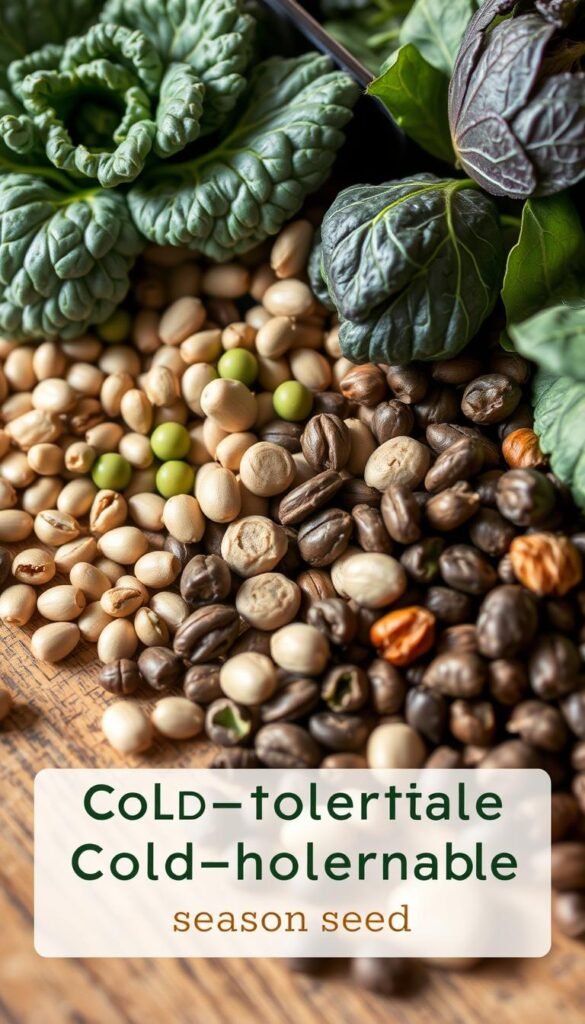
Your winter bounty begins with tiny powerhouses—seeds engineered to brave the cold. Timing and variety choice determine whether you’ll enjoy fresh meals or face empty garden beds when temperatures drop.
Smart Seed Shopping Strategies
Seeds labeled “cold-hardy” or “frost-resistant” outperform regular varieties. Winter Density lettuce, for example, survives 15°F temperatures while standard types fail at 26°F. Always check seed packets for phrases like “overwintering” or “short-day adapted.”
Reputable suppliers specializing in cool-season crops offer fresher seeds with higher germination rates. Order early—popular varieties sell out fast by midsummer.
Two Paths to Success: Soil or Trays
Root vegetables like carrots thrive when sown directly by August 1st. Their taproots dislike transplanting. Leafy greens and brassicas benefit from indoor starts—you control warmth and moisture during critical early growth.
| Method | Best For | Start Time | Key Benefit |
|---|---|---|---|
| Direct Sowing | Carrots, radishes, turnips | July-August | No transplant shock |
| Indoor Starting | Kale, cabbage, broccoli | June-July | Controlled germination |
Plant 20% extra seeds to account for slower sprouting in cool soil. Track planting dates using a calendar app—count backward from your first expected frost date. This ensures plants mature before daylight dwindles in November.
Designing Raised Beds and Container Systems for Winter Gardening
Elevated growing spaces transform how you cultivate in cooler months. Unlike traditional plots, these systems let you control critical factors like drainage and root protection. Let’s explore how to harness their potential for year-round productivity.
Why Elevated Gardens Outperform Ground Plots
Raised beds act like cozy blankets for your plants. Their loose, deep soil drains excess moisture quickly—a lifesaver when rain turns to ice. Aim for 12-inch-tall frames to keep roots safe from waterlogging and frost heave.
These structures warm faster in weak sunlight, giving crops extra growing days. You’ll appreciate the back-friendly height when harvesting through layers of row covers. For step-by-step building guidance, explore this raised bed construction tutorial.
Containers offer similar benefits with added mobility. A 5-gallon pot provides enough space for greens while retaining heat better than thin-walled options. Move them to sunny spots or sheltered areas as weather shifts.
Material Choices Matter
Double-walled planters insulate roots better than single-layer plastic. Cedar beds resist rot naturally, lasting 5-7 seasons untreated. For soil mixes, blend compost with perlite to balance nutrients and drainage.
Pair these systems with cold frames or fabric covers for maximum protection. You’ll extend harvests by weeks while keeping plants healthier through temperature swings. Smart design turns limitations into opportunities.
Planting and Timing: Maximizing Your Fall to Winter Transition

Timing your garden’s transition from summer abundance to cold-season productivity requires precision. The secret lies in working backward from your desired harvest dates, accounting for slower growth as daylight dwindles. Most plants need 2-3 extra weeks to mature once days dip below 10 hours of sunlight.
Optimal Planting Windows for Root Vegetables
Roots thrive when planted early enough to bulk up before soil chills. Carrots sown by August 1st develop sweet, sturdy roots ready for October through March harvests. Pair them with turnips and parsnips for a trio that sweetens with frost exposure.
| Crop | Planting Date | Harvest Window |
|---|---|---|
| Carrots | August 1 | October-March |
| Cabbage | Mid-August | December-January |
| Leeks | June-July | November-February |
Quick growers like radishes offer flexibility. Sow them through September for fall salads, then switch to cold-tolerant types for winter yields. Brassicas like cabbage and kale benefit from early August transplants—their established roots handle cooling soils better than seeds.
Stagger plantings every 14-21 days in late summer for continuous harvests. This crop rotation strategy ensures fresh produce flows from fall into winter. Remember: Mature plants withstand cold better than seedlings, so prioritize getting them to full size before frost.
Protection becomes key as temperatures drop. Pair your timing mastery with cold frames to extend the season further. You’ll enjoy crisp roots and leafy greens long after neighbors’ gardens go dormant.
Managing Frost and Freezing Temperatures
Protecting your plants isn’t just about survival—it’s about smart strategy. Knowing when frosts turn from helpful to harmful makes all the difference. Light chills (28-32°F) actually boost flavor in some greens, but deeper cold demands action.
Smart Protection Systems
Start with row covers—these fabric shields add 4-6°F of warmth while letting sunlight through. They’re perfect for lettuce and arugula when nights dip below freezing. For tougher conditions, cold frames act like mini greenhouses, trapping ground heat to safeguard tender roots.
Position these structures facing south to catch weak winter sun. This simple adjustment can extend your harvest window by weeks. Remember: even hardy plants appreciate extra care when temperatures plummet below 20°F.
Layer defenses based on forecasts. Floating covers handle surprise light frosts, while insulated frames defend against prolonged freezes. With the right tools, you’ll turn frosty mornings into harvest opportunities instead of losses.

